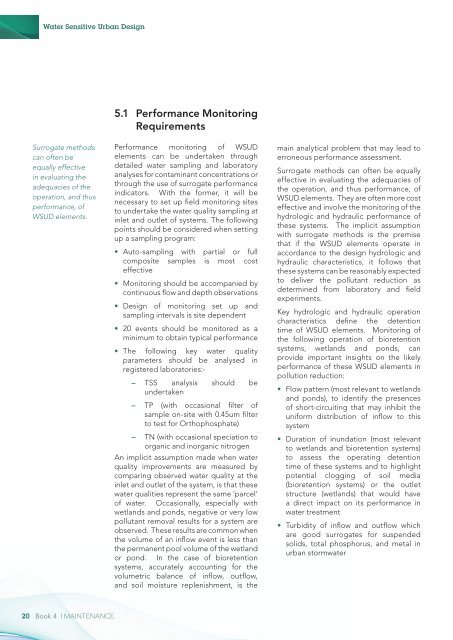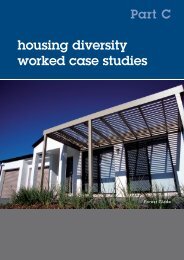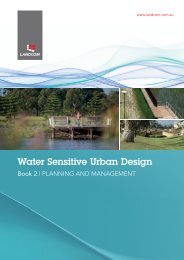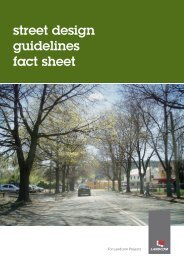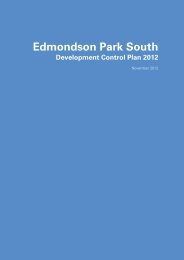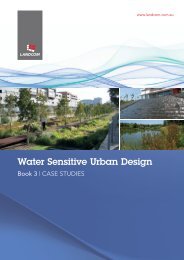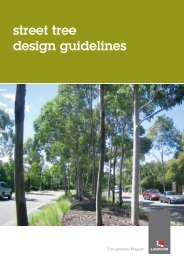Landcom Book 4 Maintenance - WSUD
Landcom Book 4 Maintenance - WSUD
Landcom Book 4 Maintenance - WSUD
Create successful ePaper yourself
Turn your PDF publications into a flip-book with our unique Google optimized e-Paper software.
Water Sensitive Urban Design<br />
5.1 Performance Monitoring<br />
Requirements<br />
Surrogate methods<br />
can often be<br />
equally effective<br />
in evaluating the<br />
adequacies of the<br />
operation, and thus<br />
performance, of<br />
<strong>WSUD</strong> elements.<br />
Performance monitoring of <strong>WSUD</strong><br />
elements can be undertaken through<br />
detailed water sampling and laboratory<br />
analyses for contaminant concentrations or<br />
through the use of surrogate performance<br />
indicators. With the former, it will be<br />
necessary to set up field monitoring sites<br />
to undertake the water quality sampling at<br />
inlet and outlet of systems. The following<br />
points should be considered when setting<br />
up a sampling program:<br />
••<br />
Auto-sampling with partial or full<br />
composite samples is most cost<br />
effective<br />
••<br />
Monitoring should be accompanied by<br />
continuous flow and depth observations<br />
••<br />
Design of monitoring set up and<br />
sampling intervals is site dependent<br />
••<br />
20 events should be monitored as a<br />
minimum to obtain typical performance<br />
••<br />
The following key water quality<br />
parameters should be analysed in<br />
registered laboratories:-<br />
––<br />
TSS analysis should be<br />
undertaken<br />
––<br />
TP (with occasional filter of<br />
sample on-site with 0.45um filter<br />
to test for Orthophosphate)<br />
––<br />
TN (with occasional speciation to<br />
organic and inorganic nitrogen<br />
An implicit assumption made when water<br />
quality improvements are measured by<br />
comparing observed water quality at the<br />
inlet and outlet of the system, is that these<br />
water qualities represent the same ‘parcel’<br />
of water. Occasionally, especially with<br />
wetlands and ponds, negative or very low<br />
pollutant removal results for a system are<br />
observed. These results are common when<br />
the volume of an inflow event is less than<br />
the permanent pool volume of the wetland<br />
or pond. In the case of bioretention<br />
systems, accurately accounting for the<br />
volumetric balance of inflow, outflow,<br />
and soil moisture replenishment, is the<br />
main analytical problem that may lead to<br />
erroneous performance assessment.<br />
Surrogate methods can often be equally<br />
effective in evaluating the adequacies of<br />
the operation, and thus performance, of<br />
<strong>WSUD</strong> elements. They are often more cost<br />
effective and involve the monitoring of the<br />
hydrologic and hydraulic performance of<br />
these systems. The implicit assumption<br />
with surrogate methods is the premise<br />
that if the <strong>WSUD</strong> elements operate in<br />
accordance to the design hydrologic and<br />
hydraulic characteristics, it follows that<br />
these systems can be reasonably expected<br />
to deliver the pollutant reduction as<br />
determined from laboratory and field<br />
experiments.<br />
Key hydrologic and hydraulic operation<br />
characteristics define the detention<br />
time of <strong>WSUD</strong> elements. Monitoring of<br />
the following operation of bioretention<br />
systems, wetlands and ponds, can<br />
provide important insights on the likely<br />
performance of these <strong>WSUD</strong> elements in<br />
pollution reduction:<br />
••<br />
Flow pattern (most relevant to wetlands<br />
and ponds), to identify the presences<br />
of short-circuiting that may inhibit the<br />
uniform distribution of inflow to this<br />
system<br />
••<br />
Duration of inundation (most relevant<br />
to wetlands and bioretention systems)<br />
to assess the operating detention<br />
time of these systems and to highlight<br />
potential clogging of soil media<br />
(bioretention systems) or the outlet<br />
structure (wetlands) that would have<br />
a direct impact on its performance in<br />
water treatment<br />
••<br />
Turbidity of inflow and outflow which<br />
are good surrogates for suspended<br />
solids, total phosphorus, and metal in<br />
urban stormwater<br />
20 <strong>Book</strong> 4 | MAINTENANCE


